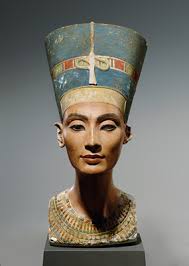Nefertiti also called Neferneferuaten-Nefertiti, was a queen (royal wife) to Pharaoh Akhenaten. Nefertiti's parents are not recorded but early Egyptologists believed that she might have been a princess from Mitanni (Syria) or she may have been a niece or daughter of Ay, who was a keeper of records under King Amenhotep III.
Nefertiti translates as ‘A Beautiful Woman Has Come,' and she became the Great Royal Wife of Egypt's most controversial Pharaoh, Akhenaton, who ruled from 1352 BC the tenth ruler of the 18th Dynasty.
Akhenaten and Nefertiti had six daughters, no son was ever shown in the many reliefs depicting the family. Her power and influence were unprecedented, temple art depicted her as performing Pharaonic privileges, serving as a priest, smiting enemies, and offering to the Aton. Her titles included Great of Favors, Possessed of Charm, Exuding Happiness, Mistress of Sweetness, Beloved One, Soothing the king's heart in his house, Soft-spoken in all, Mistress of Upper and Lower Egypt, and Lady of the Two Lands.
With the suppression of the traditional polytheistic religion in Year Four of his reign, Akhetaten built a new capitol at what is known today as Amarna and Nefertiti played an important religious role there, serving as the female element in the divine triad formed by the god Aton, Akhenaton and his queen. After Year Twelve of the reign, Nefertiti seemed to vanish from the record. She may have died at about age thirty, but there is no record of her death and no evidence that she was ever buried in the Amarna royal tomb which was never completed.
Some scholars theorize that Nefertiti may have acted as her husband's co-ruler rather than simply his consort under the name Ankhkheperure Neferneferuaten, but evidence in support of that theory is inconclusive.
As with Akhenaten, Nefertiti's mummy has not been found, although speculation continues to swirl about certain unidentified mummies from royal caches. Since Amarna was abandoned soon after Akhenaton's death, and the heretic pharaoh's cult suppressed, Nefertiti was largely forgotten until 1912 when German archaeologist, Ludwig Borchardt, discovered a portrait bust of Nefertiti in the ruins of an Amarna workshop. The bust was taken to the Egyptian Museum in Berlin where it attracted worldwide attention. Nefertiti became one of the most recognizable figures from ancient Egypt. Many consider the bust one of the greatest works of art from the ancient world.
Addtional
During her reign with her husband it was set to be the wealthiest period of Ancient Egyptian history. Nefertiti had many titles such as: Hereditary Princess , Lady of Grace, Lady of The Two Lands and Lady of all Women.
References
Nefertiti by: Anneke Bart. Retrieved October 16, 2015 http://euler.slu.edu/~bart/egyptianhtml/kings%20and%20Queens/Nefertiti.html
World Biography: Retrieved October 16, 2015 http://www.notablebiographies.com/Mo-Ni/Nefertiti.html
World time: Retrieved October 16, 2015 http://world.time.com/2012/12/06/the-bust-of-nefertiti-remembering-ancient-egypts-famous-queen
